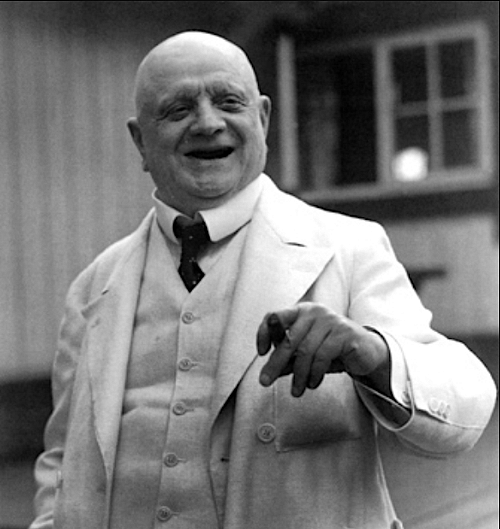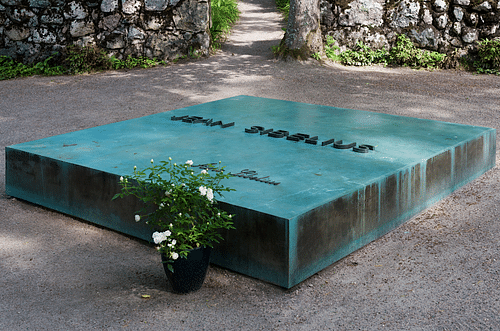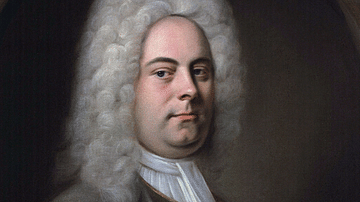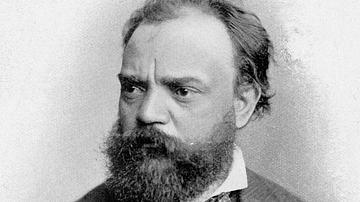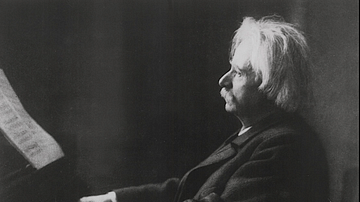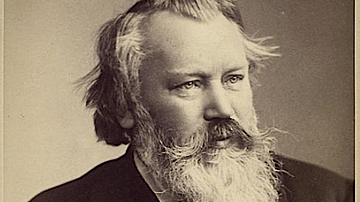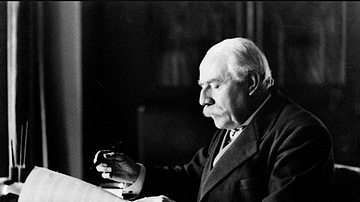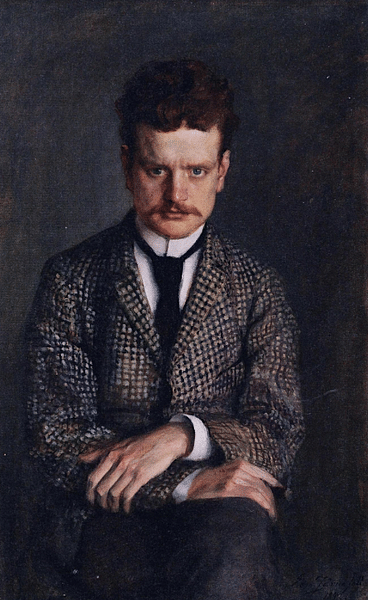
Jean Sibelius (1865-1957) was a Finnish composer famous for his symphonies, the symphonic poem Finlandia, and the Karelia Suite. Although Sibelius inspired a music revival in his native country, became a figurehead for the Finnish nationalist movement, and gained worldwide fame for his music, he did not publish any new work in the last 30 years of his life.
Early Life
Johan Sibelius (he later changed his name to Jean) was born on 8 December 1865 in Hämeenlinna in southern Finland. At the time, Finland was an autonomous grand duchy and part of the Russian Empire. Jean lost his father, a doctor, to typhoid when he was just two years old, and so he was brought up by his mother, Maria, and his grandmother who both spoke Swedish, then the language of the upper classes. Jean learned to play the violin well – his teacher was the conductor at the local Russian garrison – and he was capable of composing his own pieces at the tender age of ten.
Sibelius intended to study law but changed his mind and decided to pursue a career in music. Sibelius entered the Conservatory of Helsinki in 1886 and studied there for two years. One of his tutors was Martin Wegelius (1846-1906), who had founded the Helsinki Music Institute (which was, appropriately enough, later renamed the Sibelius Academy). Another teacher who influenced Sibelius, this time one almost the same age as the pupil, was the pianist and composer Ferruccio Busoni (1866-1924). Sibelius moved on to study music in Berlin and Vienna before returning to Finland in 1891 where he earned money teaching. One final influence on the young composer was the work of fellow-Scandinavian Edvard Grieg (1843-1907) who not only gave his experience and money to help Sibelius but, perhaps more importantly, he also showed that a composer could gain international acclaim even if they were not from the traditional musical heartland of central Europe.
Sibelius was influenced by both the landscape and the music of his own country. He once said, "Give me the loneliness either of the Finnish forest or of a big city" (Thompson, 170), and an important cultural influence was the Kalevala, a 19th-century epic poem drawn from Finnish folk tales. One of the composer's first major works was the symphonic poem Kullervo, which was based on the Kalevala. The symphony poem, also called a tone poem, is a symphonic work inspired by a non-musical subject. Sibelius once explained his loyalty to this genre: "Here I can move freely without feeling the weight of tradition" (Sadie, 296). Kullervo has five movements and employs an orchestra, soloists, and a male choir. It was a huge success in 1892, and Sibelius' career was launched.

Sibelius' music would continue to possess a flavour of Finland, but he does not directly use folk tunes. In 1893 he began work on his Lemminkünen Legends (aka Four Legends), four symphonic poems based on the adventures of the Finnish folk hero Lemminkäinen who appears in the Kalevala. The most famous of the quartet is Tuonelan joutsen (The Swan of Tuonela) where Sibelius memorably has an English horn represent the sound of the swan while strings and harp present the river upon which it glides. The Swan was actually written as the prelude to an opera, but the composer abandoned the larger project. Another two symphonic poems inspired by local folklore were En saga and Skogsrået (The Wood-nymph). The instrumental music of Karelia was reorganised into an orchestral suite by the composer in 1893.
Character & Family
The music historian M. Steen gives the following physical description of Sibelius in his youth: "He was then tall, with bushy chocolate-coloured hair and a moustache. He himself said that he could subdue a lion with the glance of his piercing, blue, falcon-like eyes." (738)
Sibelius, because several of his works were inspired by Finnish literature, became strongly associated with the nationalist movement. This link was reinforced when the composer married Aino, the daughter of a Finnish nationalist, Major-General Järnefelt. Aino brought in money through her translation work of French literature, and the couple went on to have five daughters. Sibelius was a heavy drinker. He was not much good at managing his finances and was almost always in debt until the Finnish state rescued him in 1897 by awarding him a state pension. This was some compensation for his failure to secure the coveted position of Professor of Music in Helsinki. The composer also benefitted from handouts from various private benefactors. Nevertheless, Sibelius' alcoholism and poor financial management put a constant strain on his marriage.

From 1904, Sibelius lived in a large purpose-built house he called Ainola by Lake Tuusula outside Järvenpää, some 38 kilometres (24 mi) northeast of Helsinki. The great wooden villa still stands, secluded in a pocket of pine and birch trees. The composer travelled extensively, spending time in England, Italy, and Bohemia, but he always returned to Ainola. He walked through the forests near his home, and when he did not, Sibelius carried a matchbox filled with moss in his pocket so that he could remind himself of the smell of nature whenever he wished. Ainola was filled with the composer's impressive collection of Finnish art. He listened to gramophone records deep into the night, smoking the expensive cigars that tobacco companies were only too willing to supply for free to one of the world's most famous cigar lovers.
Finlandia
Sibelius completed his rousing symphonic poem Finlandia in 1899, but, always something of a tinkerer with his work, he revised it in 1900. Although the piece has become symbolic of Scandinavia and the Finnish nationalist movement, it was actually written for a much more mundane purpose: to help raise cash for a Helsinki press pension fund. The piece was played as the finale of a pageant celebrating Finnish history and culture. The work did rouse nationalist supporters and for this reason, it was banned by the Russian Tsar Nicholas II (r. 1894-1918). Today, Finlandia is Sibelius's most famous work, but even in his own lifetime, the composer was a little baffled by its particular popularity as he considered it a "pretty insignificant piece in relation to the rest" (Steen, 739).
Symphonies & Later Works
From 1899, Sibelius wrote seven symphonies, the seventh being completed by 1924. He also wrote an eighth symphony in 1929, but, dissatisfied with it, he destroyed all trace of it. One can imagine the manuscript went into the great hearth at Ainola. The music historian Robert Layton notes that "Few composers identified themselves more strongly with nature than did Sibelius. The seven symphonies lie at the heart of his achievement and span his creative career like an Alpine chain" (Arnold, 1685). Music critics have seen an increasingly austere style as Sibelius' symphonies progress, perhaps not unconnected with a diagnosis of throat cancer in 1908. However, the composer himself once described the symphony format as requiring a "severity of form and the profound logic that creates an inner connection between all the motifs" (Sadie, 388). More poetically, Sibelius once said that a symphony should be "a river with innumerable tributaries feeding it before it broadens majestically and flows into the sea" (Layton, 2012).
From the Fourth Symphony onwards, Sibelius became very fond of using short melodic and rhythmic motifs which he repeats and expands through the work, a technique known as ostinato. He often favours woodwinds and sets these against more subdued strings.
Sibelius continued to write symphonic poems such as Pohjolan tytär (Pohjola's Daughter, 1906) and Oinen ratsastus ja auringonnousu (Night-ride and Sunrise). Another instrumental work was the music written for the play Pelléas et Mélisande by Maurice Maeterlinck. Belsazars gästabud (Belshazzar's Feast) was also given a score by Sibelius in 1906. His 1904 Valse triste was a success at home and abroad. In 1905, the composer revised his violin concerto which had first been performed two years earlier. He briefly returned to chamber music with his String Quartet in D minor (Voces intimae), composed in 1909.
As already noted, Sibelius was suffering from throat cancer, and this was treated with a string of operations from 1908, which eventually cured him. He still managed to tour Europe presenting his work, and then he did the same in the United States. The fame of the composer was also greatly helped by a series of gramophone records of his music. Once in his mid-50s, Sibelius reduced his composing, indeed, he only wrote four more major works. These included a score for a 1925 production of The Tempest by William Shakespeare and the highly-regarded symphonic poem Tapiola in 1926. Sibelius was asked to give an explanatory poem to Tapiola by his publisher Breitkopf & Härtel. He wrote:
Widespread they stand, the Northland's dusky forests,
Ancient, mysterious, brooding savage dreams;
Within them dwells the Forest's mighty god.
And wood sprites in the gloom weave magic secrets.
(Layton, 1996)
In his last three decades, Sibelius did not write music at all and even became reluctant to talk about his work. Perhaps he had become too self-critical, as we know he was with his Eighth Symphony, and he could not bring himself to make public any of the works he was composing in this period despite receiving prestigious commissions. Already, when he was revising his Fifth Symphony in 1919, Sibelius lamented in his diary, "My heart sings, full of sadness – the shadows lengthen" (Layton, 2012).
Certainly, the world of classical music had been transformed after WWI, yet Sibelius, at least for a while, had pressed on with a largely unaltered Romantic style he himself described as "'offering pure spring water' at a time when others were mixing cocktails of various hues" (Arnold, 1685). Despite the new trends established by such composers as Igor Stravinsky (1882-1971) and Béla Bartók (1881-1945), Sibelius' music remained extremely popular in both England and North America through the 1930s and 1940s.
Sibelius' Major Works
The most popular works by Jean Sibelius include:
7 symphonies
Kullervo choral symphony (1892)
En saga orchestral work (1892-1902)
Lemminkünen Legends symphonic poem quartet (1893-7)
Karelia Suite (1893)
Finlandia symphonic poem (1899)
Violin Concerto (1903-5)
Valse Triste (1904)
Pohjolan tytär symphonic poem – Pohjola's Daughter (1906)
String Quartet in D minor aka Voces intimae (1909)
The Tempest Suite (1925)
Tapiola symphonic poem (1926)
Sibelius was tremendously popular in his own lifetime – listeners to a US radio station voted him the most popular composer in the world in the 1930s – but his self-imposed silence in his last three decades did nothing to help perpetuate his fame after his death. Still, perhaps he was content to simply retire in his mid-60s like everyone else. Ultimately, Sibelius drifted from being regarded as a great composer to a minor one.
While there was a revival of interest in the latter part of the 20th century and certain of his works are still highly regarded by music critics, there are some that point to the inconsistencies in the large body of work Sibelius produced. As the music historian C. Schonberg notes, "It cannot be denied that a large quantity of Sibelius's work – and he was a prolific composer – consists of ephemera. His violin works, apart from the D-minor Concerto, are salon trifles, and his songs are competent without being striking…[but] in years to come the chances are that the music of Sibelius will occupy a more prominent place than it currently does" (454). There were some staunch supporters of Sibelius, especially in the Anglo-Saxon world but even in Germany, where he was almost totally forgotten. The celebrated conductor Herbert von Karajan (1908-1999) took over the Berlin Philharmonic Orchestra in 1955 (he would remain at its head for the next 34 years), and he insisted at his very first concert performance that Sibelius' Fourth Symphony be represented in the repertoire. The growing list of great conductors who have recorded complete cycles of Sibelius' work shows that von Karajan was not alone in his admiration.
Death & Legacy
Towards the end of his life, Sibelius became something of a recluse at Ainola, although he received many distinguished visitors there such as the Finnish president for his 85th birthday. Jean Sibelius died in Järvanpää on 20 September 1957; he was 92. His state funeral was held in Helsinki Cathedral, and he was buried at his beloved Ainola. Today, Ainola is a museum dedicated to the composer.
Finlandia continues to represent Sibelius (and Finland) in all sorts of odd places; it was used, for example, in the soundtracks of two 1990 Hollywood blockbusters: The Hunt for Red October and Die Hard 2. Commemorated with monuments and competitions in his name, and with his manuscripts now part of the UNESCO Memory of the World Programme, one is tempted to think that the tribute the composer would find most appealing, given the profound impression nature had made upon him, is the naming after him of the minor planet discovered in 1936 by a Finnish astronomer. This asteroid orbits the Sun and is now called 1405 Sibelius.
